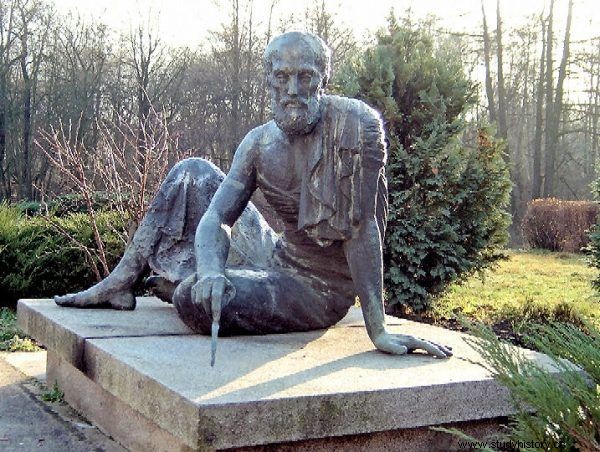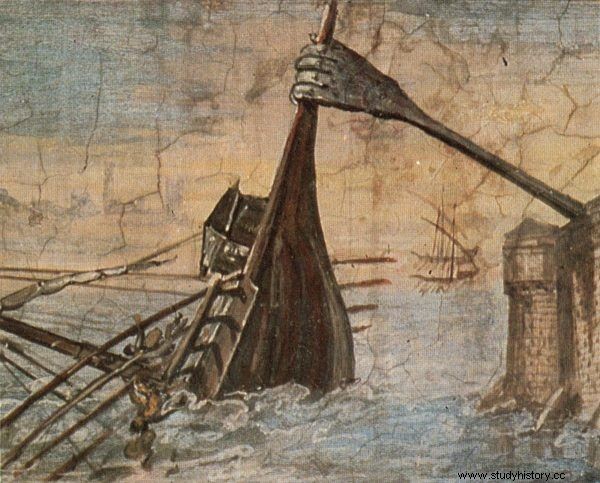The figure of the Greek scientist is associated today mainly with jumping out of the bathtub naked, and thus with the well-known law of physics. This - perhaps the most important of his discoveries - was not the only one ...
Life in antiquity was not peaceful, and Archimedes definitely did not spend much time sitting in the bathtub. On the contrary:he was equally involved in science and the art of war, and according to modern standards, his character could compete with fictional superheroes.
Stormy beginnings
Archimedes' origin is shrouded in mystery. It is known that he was born in Syracuse, founded according to legends by a certain Archias in 733 or 734 BC. The colonist allegedly murdered the object of his affection - young Aketon, by accident. It was then that the father of the deceased committed suicide, summoning the gods to help him get revenge.
Bad times of drought and famine ensued, which the people of Syracuse believed were caused by an angry Poseidon. Archias fled, thus avoiding the sacrificial altar, leaving the city to its fate. Reportedly, when he was tracked down and killed by Telephos, Poseidon restored prosperity and Syracuse flourished.

Archimedes was also an inventor
Hundreds of years later, at the beginning of the 3rd century BC, it was probably the most powerful and economically strong city in the Mediterranean. It was then that Archimedes was born - the son of the astronomer Phidias, a distant relative of the city's ruler, Hieron II (if you believe Plutarch's notes).
Historians say that Archimedes studied in Alexandria, where he met other personalities of ancient science, including the diligent observer of the sky and solar eclipses, Conon of Samos, and Eratosthenes of Cyrene, who first estimated that the Earth was a sphere. So he was definitely in the cream of the intellectual society of his time.
The man who picked up the ship
Archimedes was fascinated by proportions - not only in geometry, but also in practice, where he used them to achieve goals that might seem impossible at the time. In the first book of the work "On the balance of planes", the scholar focuses on the possibilities associated with the use of levers. As he himself claimed, with a sufficiently long mechanism, he could move the entire Earth. Admittedly, he had a tendency to exaggerate, but…

Archimedes Monument - Berlin, Alt-Treptow, Archenhold Observatory garden
He was also able to prove that his boasts were not words thrown to the wind. During a show organized for King Hieron, Archimedes had one of the merchant ships loaded with goods and brought the crew on board. Then he sat down quietly at a distance and, pulling the handle of the pulley mechanism, lifted the ship up from the water. For this he only used the strength of his own muscles and a clever device. Thus, he made a great impression on the ruler and all observers, not to mention the ship's crew ...
Archimedes' inventions based on levers found many uses, including during the siege of Syracuse by the Romans during the Second Punic War.
Stone and laser
When the army of Marcus Claudius Marcellus stood outside the walls of Syracuse, many soldiers thought that the cities were defended by the gods themselves. The attackers were showered with a barrage of missiles from machines created by Archimedes, who directed the engineering work during the preparations for the defense. It was thanks to the knowledge of a simple device, which is a lever, that the scientist was much ahead of his time and showed what can be achieved with an efficient mind.
But that's not all. The ships sailing to Syracuse, if you believe Emperor Lucian's notes, suddenly caught fire! This was due to a device based on mirrors or lenses, designed by Archimedes. The accounts of the Roman ruler on this issue are unclear, and the remains of the legendary device have not survived to our times. Many attempts have been made - for example, in 1973 near Athens, it was possible to set fire to a model of a ship using seventy mirrors reflecting the sun's rays. In 2005, MIT students set fire to another mock-up, but they had to concentrate the light for about 10 minutes, contrary to the dozen or so seconds reported by the experimenters near Athens. Ultimately, the problem of the Archimedes mirror weapon fell into the hands of the creators of the popular series "Mythbusters", in which the possibility of its existence was "finally" refuted.

Archimedes claw
Some historians have suggested that Archimedes did not have to keep his device in one place on the city walls. Perhaps - which would have proved much more effective - he had troops of soldiers equipped with mirrors to direct reflections from a much larger part of the coast? However, we will probably never know that.
Another weapon that the defenders of Syracuse would use was the so-called "claw of Archimedes", a kind of lever used to lift enemy ships from the water and sink them. This device was even reconstructed and put into practice in the 2005 "Superbrony of the Ancient World" program.
Death by accident?
After the capture of Syracuse by the soldiers of Marcus Claudius, Archimedes was killed by the sword. There are also various legends about his death. One says that the scientist was so preoccupied with another geometric problem that he was killed… impatiently, despite clear orders to take him alive. According to legend, he was supposed to say "Don't blur my circles" when referring to the geometric shapes drawn. Another version of the story is that the soldiers killed him because they found the drawing instruments valuable and simply wanted to steal them.
One way or another, the great designer was most likely killed in 212 BC, at about 75 years of age. He left behind a lot of knowledge that we still use today.
Bibliography:
- Hawking, S., God Created The Integers:The Mathematical Breakthroughs that Changed History. Running Press, 2007.
- Collective work, Great History of the World. T. 8. Polish Media Amer.Com, 2005.
- Stewart, I., A Brief History of Great Minds. Prószyński i S-ka, Warsaw 2019.
